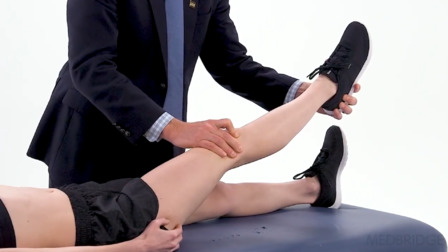Evidence-Based Examination of the Shoulder: An Update
Presented by Eric Hegedus
12-Month Subscription
Unlimited access to:
- Thousands of CE Courses
- Patient Education
- Home Exercise Program
- And more
Non-Financial: Eric Hegedis cites his research in this course, but does not use the course for the purpose of promoting his own research.
In this course, users will evaluate the impact and prevalence of shoulder dysfunction, understand the imperative patient history elements of a shoulder examination, and identify which patient history components are affiliated with shoulder pathology. The most common forms of self-report outcomes measures for the shoulder are presented and discussed. Viewers will also identify the most prevalent red flags encountered during the shoulder examination and differentiate the purposes of each screening test for problems meriting referral. An objective is to synthesize the importance of specific, meaningful clinical findings during the examination process and evaluate the benefit of palpation and manual muscle testing as part of a dedicated clinical examination. Current research is presented throughout the course to provide learners with the proper tools for evidence-based management of these patients. This course is part of a comprehensive clinical series covering examination and intervention for the cervical, thoracic, and lumbar spine, as well as the upper (shoulder, elbow, wrist, and hand) and lower (hip, pelvis, knee, foot, and ankle) quarters.
Meet your instructor

Eric Hegedus
Dr. Eric J. Hegedus has had a notable 21-year career as a leader and innovator in physical therapist education, research, and clinical practice and is founding chair of the Doctor of Physical Therapy Department at High Point University. Dr. Hegedus also is founder and director of Targeted Enhanced Athletic Movement (TEAM), a…
Chapters & learning objectives

1. Prevalence, Incidence, and Etiology of Shoulder Pain/Pathology
In this chapter, learners will evaluate the economic impact of shoulder dysfunction and consider the prevalence/incidence of shoulder pain and how this influences clinical practice. In addition, prognostic factors of positive and negative outcomes will be discussed. The overall burden of shoulder pain is discussed in comparison to other musculoskeletal and nonmusculoskeletal conditions worldwide.

2. Patient History and Outcomes Assessment
In this chapter, learners will discuss the imperative patient history elements of a shoulder examination and define which patient history components are affiliated with shoulder pathology. Learners will also discuss the most common forms of self-report patient outcomes measures, as well as their validity.

3. Observation
In this chapter, learners will identify the link between observation of posture and shoulder pain or dysfunction. Learners will also identify benefits of general observation of a patient’s expression of fear, anxiety, or distress.

4. Triage and Screening
In this chapter, learners will identify the most prevalent red flags germane to the shoulder examination. The chapter will compare and contrast the purposes of each screening test for sinister problems. Learners will also analyze the triggers that would prompt the use of a test for ruling out a condition and evaluate the benefit of performing these “ruling out” actions first within the examination. Lastly, learners will understand structural differentiation.

5. Motion Testing
This chapter will synthesize the importance of the movement assessment and will contrast the goals of the three primary phases of the initial examination.

6. Palpation, Muscle Testing, and Performance
This chapter will evaluate the benefit of palpation as part of a dedicated clinical examination. Learners will also evaluate the benefit and types of muscle testing for the shoulder.
More courses in this series

Crucial Factors Influencing Health & Recovery in Musculoskeletal Care
Chad Cook

Evidence-Based Examination of the Cervical Spine: An Update
Chad Cook

Evidence-Based Treatment of the Cervical Spine: An Update
Chad Cook

Cervical Spine Examination and Treatment: Cases to Synthesize Learning
Chad Cook

Evidence-Based Examination of the Thoracic Spine: An Update
Chad Cook

Evidence-Based Treatment of the Thoracic Spine: An Update
Chad Cook

Thoracic Spine Examination and Treatment: Cases to Synthesize Learning
Chad Cook

Evidence-Based Examination of the Lumbar Spine: An Update
Chad Cook

Evidence-Based Treatment of the Lumbar Spine: An Update
Chad Cook

Lumbar Spine Examination and Treatment: Cases to Synthesize Learning
Chad Cook

Evidence-Based Examination of the Elbow, Wrist, and Hand: An Update
Chad Cook

Evidence-Based Treatment of the Elbow, Wrist, and Hand: An Update
Chad Cook

Elbow, Wrist, and Hand Examination and Treatment: Cases to Synthesize Learning
Chad Cook

A Primer on Exercise and Treatment Prescription
Alexis Wright

Evidence-Based Examination of the Hip: An Update
Alexis Wright

Evidence-Based Treatment of the Hip: An Update
Alexis Wright

Hip Examination and Treatment: Cases to Synthesize Learning
Alexis Wright

Evidence-Based Examination of the Foot and Ankle: An Update
Alexis Wright

Evidence-Based Treatment of the Foot and Ankle: An Update
Alexis Wright

Foot and Ankle Examination and Treatment: Cases to Synthesize Learning
Alexis Wright

Evidence-Based Examination of the SIJ/Pelvis
Alexis Wright

Evidence-Based Treatment of the SIJ/Pelvis
Alexis Wright

A Primer on Examination and Treatment Metrics
Eric Hegedus

Evidence-Based Examination of the Shoulder: An Update
Eric Hegedus

Special Tests of the Shoulder
Eric Hegedus

Evidence-Based Treatment of the Shoulder: An Update
Eric Hegedus

Management of the Shoulder: Case-Based Vignettes
Eric Hegedus

Evidence-Based Examination of the Knee and Thigh: An Update
Eric Hegedus

Special Tests of the Knee
Eric Hegedus

Evidence-Based Treatment of the Knee and Thigh: An Update
Eric Hegedus

Management of the Knee and Thigh: Case-Based Vignettes
Eric Hegedus
